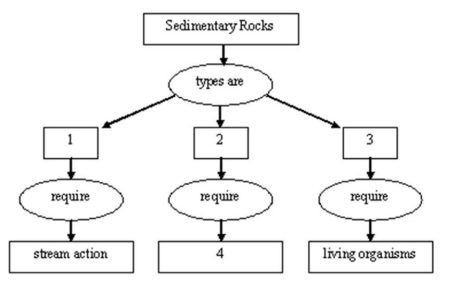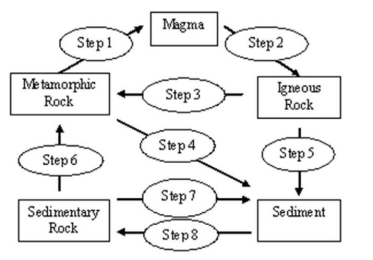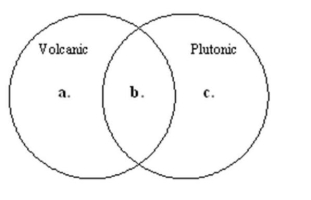Correct Answer

verified
Correct Answer
verified
Multiple Choice
Suppose you pick up a rock that formed from the sediments of weathered rocks. What type of rock have you found?
A) Clastic
B) Chemical
C) Biochemical
Correct Answer

verified
Correct Answer
verified
Multiple Choice
Complete the following concept map.
 -Complete the following concept map for number 3.
-Complete the following concept map for number 3.
A) Biochemical
B) Chemical
C) Clastic
D) Evaporation
Correct Answer

verified
A
Correct Answer
verified
Multiple Choice
Which processes would change an igneous rock to a sedimentary rock?
A) Weathering, transport, and lithification
B) Melting and crystallization
C) Increased temperature and pressure
Correct Answer

verified
Correct Answer
verified
Multiple Choice
Where would you most likely find regional metamorphism?
A) Associated with a mountain belt
B) Associated with a volcano
C) Associated with a fault
Correct Answer

verified
Correct Answer
verified
Multiple Choice
Which of the following would be a small grained igneous rock?
A) Limestone
B) Basalt
C) Marble
D) Quartz
Correct Answer

verified
Correct Answer
verified
Multiple Choice
Which of the following would have a unique chemical composition and a crystalline structure?
A) Limestone
B) Basalt
C) Marble
D) Quartz
Correct Answer

verified
Correct Answer
verified
Multiple Choice
The following diagram illustrates the Rock Cycle.
 -The diagram illustrates the Rock Cycle. Match the letters below to the step number 4 on the diagram.
-The diagram illustrates the Rock Cycle. Match the letters below to the step number 4 on the diagram.
A) Cementation and compaction (lithification)
B) Heat and pressure
C) Weathering, transportation, deposition
D) Cooling and solidification
E) Melting
Correct Answer

verified
Correct Answer
verified
Multiple Choice
Complete the following concept map.
 -Complete the following concept map for number 2.
-Complete the following concept map for number 2.
A) Biochemical
B) Chemical
C) Clastic
D) Evaporation
Correct Answer

verified
Correct Answer
verified
Multiple Choice
Where would you most likely find contact metamorphism?
A) Associated with a mountain belt
B) Associated with a volcano
C) Associated with a fault
Correct Answer

verified
Correct Answer
verified
Multiple Choice
What determines the atomic number of an element?
A) The number of electrons
B) The number of protons
C) The number of neutrons
Correct Answer

verified
Correct Answer
verified
Multiple Choice
Use the Venn diagram shown below to answer this question.
 -Which section of the diagram forms at the surface?
-Which section of the diagram forms at the surface?
A) Volcanic
B) Both Volcanic and Plutonic
C) Plutonic
Correct Answer

verified
Correct Answer
verified
True/False
Plutonic igneous rocks form at or very near the surface.
Correct Answer

verified
Correct Answer
verified
Multiple Choice
The following diagram illustrates the Rock Cycle.
 -The diagram illustrates the Rock Cycle. Match the letters below to the step number 5 on the diagram.
-The diagram illustrates the Rock Cycle. Match the letters below to the step number 5 on the diagram.
A) Cementation and compaction (lithification)
B) Heat and pressure
C) Weathering, transportation, deposition
D) Cooling and solidification
E) Melting
Correct Answer

verified
Correct Answer
verified
Multiple Choice
Which one of these is a low silica rock that cooled at the surface?
A) Granite
B) Rhyolite
C) Gabbro
D) Basalt
Correct Answer

verified
D
Correct Answer
verified
Multiple Choice
Complete the following concept map.
 -Complete the following concept map for number 4.
-Complete the following concept map for number 4.
A) Biochemical
B) Chemical
C) Clastic
D) Evaporation
Correct Answer

verified
Correct Answer
verified
Multiple Choice
Use the Venn diagram shown below to answer this question.
 -Which section of the diagram represents small-grained rocks?
-Which section of the diagram represents small-grained rocks?
A) Volcanic
B) Both Volcanic and Plutonic
C) Plutonic
Correct Answer

verified
Correct Answer
verified
True/False
For each increase in hardness on the Moh's scale, the hardness increases by a factor of 10.
Correct Answer

verified
False
Correct Answer
verified
Multiple Choice
Use the Venn diagram shown below to answer this question.
 -Which section of the diagram includes high silica rocks?
-Which section of the diagram includes high silica rocks?
A) Volcanic
B) Both Volcanic and Plutonic
C) Plutonic
Correct Answer

verified
Correct Answer
verified
True/False
The rock cycle links different types of minerals to one another by processes.
Correct Answer

verified
Correct Answer
verified
Showing 1 - 20 of 47
Related Exams